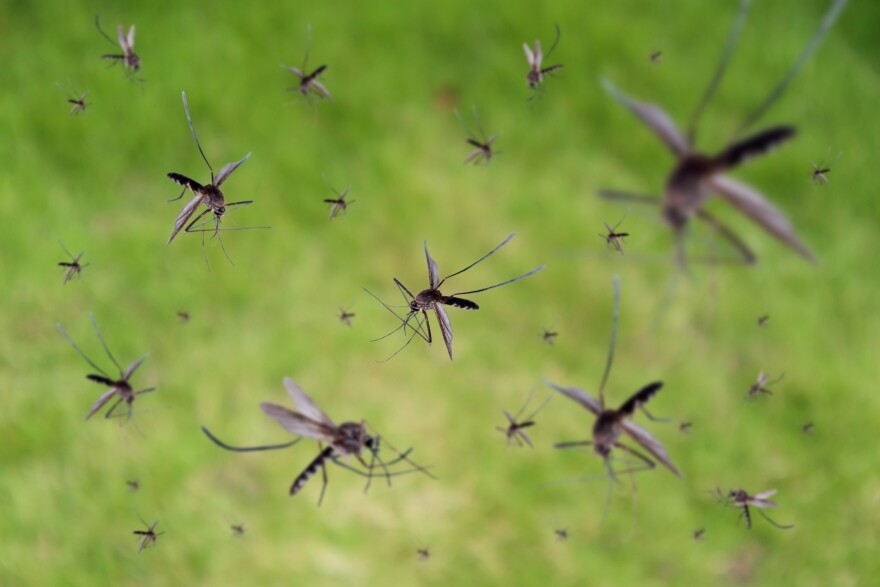Truth matters. Community matters. Your support makes both possible. LAist is one of the few places where news remains independent and free from political and corporate influence. Stand up for truth and for LAist. Make your year-end tax-deductible gift now.
Here Come The Mosquitoes! Just How Bad Things Will Be And Other Things You Should Know

Mosquitoes need water to lay their eggs, and no doubt you’ve noticed the Southland has been getting a lot of rain in the last few months. So the question begs, will we be looking at an uptick in blood-sucking insects?
“The short answer is: Yes, you might expect a larger abundance of mosquitoes,” said Ryan Harrigan, a biologist at UCLA who studies vector borne diseases.
So far, that forecast seems to be in line with the experience of the Greater Los Angeles Vector Control District, which monitors mosquitoes and related diseases in the region.
“We are seeing some elevated numbers, in comparison to some of our five year averages,” said Steve Vetrone, director of scientific-technical services at the agency.
Why do mosquitoes tend to thrive after it rains?
The logic is pretty simple: Mosquitoes lay their eggs in standing water. After it rains, there are often more places for them to breed.
In Southern California, Vetrone added, the top two mosquito-breeding sources are unmaintained swimming pools and backyard containers. According to his agency, a single “green” swimming pool — with dirty, algae-filled water — can produce up to 3 million mosquitoes in one month.
“Stagnant water is a huge deal,” said Harrigan at UCLA. “Even a bottle cap full of water is enough for mosquitoes to lay eggs and reproduce.”
Backyard containers can be just about anything that’s left outdoors, said Harrigan, from old tires to empty flower pots.
Know your enemy: What kind of mosquitoes are we dealing with?
Southern California has two mosquito species. This includes the traditional Culex tarsalis mosquitoes, which “tend to only bite at dawn and dusk, or in the evening,” said Harrigan. In recent years, residents have also had to grapple with Aedes mosquitoes, colloquially known as the “ankle biters,” which bite during the day and “typically try to go for parts of the body with thin skin, like your wrists or ankles,” he added. Aedes mosquito bites are usually more itchy.
Aedes mosquitoes are also an invasive species. “They haven't been here traditionally,” said Harrigan. “But, because of global warming, you're seeing more of [them] in Southern California.”
Both species “have the potential to transmit some very nasty diseases,” said Vetrone. Culex tarsalis mosquitoes, which like to breed in swimming pools, are responsible for the transmission of the West Nile virus and St. Louis encephalitis. Aedes mosquitoes, which prefer breeding in the “smaller, more cryptic” containers, can transmit dengue and chikungunya.
A couple of counterintuitive facts about mosquitoes
Larger mosquito populations do not necessarily mean residents will experience more biting, said Harrigan. The female insects also feed on other mammals, including pets, and other warm-blooded animals, like birds.
In some parts of L.A. County, lots of rainwater can sometimes help decrease mosquito populations, said Vetrone. That’s because the insects also like to breed in underground storm drains, particularly in sections that are old and in disrepair. Pools of water can accumulate in those sections, and they tend to maintain a favorable temperature and humidity all year long.
“With big rains, we have a significant amount of water entering those systems,” said Vetrone. And all that rainwater can flush out debris, allowing water to flow and destroying mosquito breeding sources.
“Significant rainfall does help us,” said Vetrone, “but it creates problems in other ways.”
How can I prevent mosquito population growth?
From now through the rest of the summer, Vetrone recommends that SoCal residents take a close look around their property at least once a week.
“Make sure there isn't anything holding any water that would create a mosquito breeding source,” he said. “And even if it's not currently holding water, if it has the ability to, we ask that residents invert those [items].”
SoCal residents should also maintain their pools. And if you’re using barrels to collect rainwater, Vetrone said, make sure they’re well-sealed.
“[Rain barrels] tend to create a very, very suitable place for mosquitoes to breed,” he said. This can create a problem not just for those who live in the home, but for everyone in the neighborhood.
If you encounter a serious mosquito uptick, you can also submit a service request at your local vector control district. These agencies will send an inspector to your home, who will work to identify any potential breeding sources, provide guidance, and address other potential sources nearby.
“Mosquito control is a shared responsibility,” Vetrone said. “We are definitely out there doing our part.”








